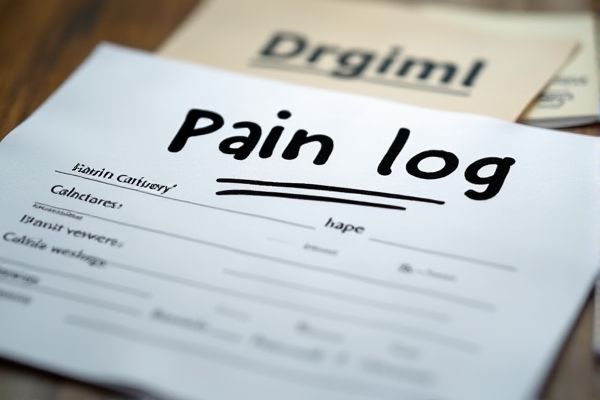Pain log Excel templates offer a structured way to track and analyze pain levels, triggers, and patterns over time. These templates often include fields for date, time, type of pain, intensity on a scale, and any associated activities or medications. By utilizing these customizable templates, you can easily visualize your pain management journey, providing insight for healthcare professionals and aiding in personal wellness strategies.
Pain log Excel template
Chronic pain log
A Chronic Pain Log Excel template serves as a systematic tool for tracking your pain levels, triggers, and the effectiveness of various treatments over time. This organized spreadsheet allows you to record data such as pain intensity on a scale, the location of pain, and any medications or therapies administered. Visual representations, like graphs or charts, can be generated to help identify patterns, making it easier for you and your healthcare provider to tailor your pain management approach. Beyond basic tracking, advanced features such as automated reminders and detailed statistical analyses can further optimize your understanding of chronic pain's impact on your life.
💾 Chronic pain log template .xls
Pain management journal
A Pain Management Journal Excel template organizes and tracks pain-related data, allowing individuals or healthcare providers to monitor symptoms over time. This template typically includes columns for date, pain intensity, triggers, duration, and medications used, providing a clear visual representation of trends and patterns. Users can customize their entries to include specific notes about activities or emotional factors that may influence pain levels. By utilizing this structured approach, you can enhance your understanding of pain dynamics, which is vital for developing effective strategies and identifying potential advanced treatment options like biofeedback or neuromodulation therapies.
💾 Pain management journal template .xls
Patient pain diary
A Patient Pain Diary Excel template is a structured tool designed to help individuals track and record their pain experiences over time. It typically includes sections for date, time, pain intensity (often rated on a scale), duration, location, and any accompanying symptoms or triggers. This detailed logging allows healthcare providers to analyze patterns and adjust treatment plans based on consistent data you provide. By utilizing such a template, you can also explore advanced concepts like pain thresholds, medication efficacy, and behavioral correlations in pain management strategies.
💾 Patient pain diary template .xls
Headache pain log
A headache pain log Excel template is a structured tool designed to help individuals track and analyze their headache occurrences and associated symptoms. This customizable spreadsheet allows you to input specific details such as the date, time, intensity level, duration, triggers, and any medications taken. By organizing this information, you can identify patterns and correlations that may assist healthcare providers in diagnosing and recommending effective treatments. Your headache management strategies can evolve as you explore advanced analytical methods like pivot tables and conditional formatting for deeper insights.
💾 Headache pain log template .xls
Post-surgery pain log
A Post-surgery pain log Excel template is a digital tool designed to help patients track their pain levels following a surgical procedure. Each entry often includes date, time, pain intensity on a scale from 1 to 10, types of pain relief used, and any side effects experienced. This comprehensive documentation allows for clear communication with healthcare providers, ensuring that any potential issues can be addressed promptly. By utilizing this template, you not only manage immediate discomfort but also pave the way for more advanced analyses, such as trends in recovery or the effectiveness of specific pain management strategies.
💾 Post-surgery pain log template .xls
Pain level chart
A Pain Level Chart Excel template is a structured tool that allows users to record and evaluate pain intensity over a specified timeframe. It typically features a grid layout where different pain levels, often rated from 1 to 10, are mapped against various time intervals or activities. You can easily input data related to the type, location, and duration of pain, creating a visual representation that facilitates better understanding and management of pain symptoms. For future needs, this template can be adapted for more advanced analysis, such as trend forecasting or medication effectiveness assessments, using statistical functions and data visualization techniques like pivot tables or advanced charting options.
💾 Pain level chart template .xls
Back pain tracking
A back pain tracking Excel template is a structured tool designed to help individuals monitor and analyze their back pain symptoms over time. This template typically includes columns for date, pain severity on a scale from 1 to 10, specific activities, triggers, and notes on remedies or treatments used. By inputting this data regularly, you can identify patterns related to your back pain, such as activities that worsen or alleviate the discomfort. Tracking your pain can serve as a valuable resource for healthcare providers, potentially leading to more effective treatment plans and a deeper understanding of your condition, allowing for the application of advanced analytical methods like regression analysis or predictive modeling if required.
💾 Back pain tracking template .xls
Pain assessment
A Pain Assessment Excel template serves as a systematic tool designed to track and evaluate pain experiences over time. It includes sections for recording pain intensity, duration, location, and triggers, enabling a comprehensive overview of an individual's pain patterns. Customized columns allow users to integrate medication usage, relief techniques, and associated symptoms, making it easier to identify trends and correlations. You can leverage this template not only for basic recording but also for sophisticated data analysis, including predictive modeling and longitudinal studies on pain management strategies.

